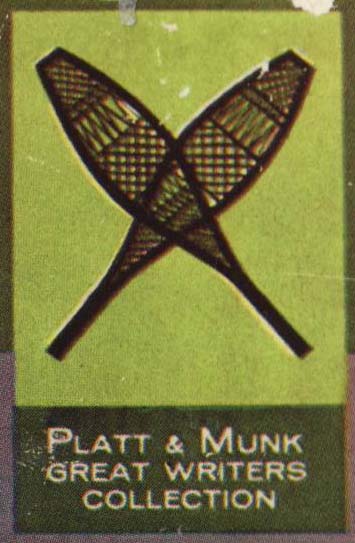Platt & Munk (New York, US)
Series dates: 1960-1965
Size: 6″ x 8.25″
Platt & Munk was established in 1921 and acquired by Grosset & Dunlap in 1977. The firm almost exclusively published children’s books. Their most famous is The Little Engine that Could, published in 1930 in the name of the Platt & Munk house pseudonym, Watty Piper. Most sources attribute the story to Arnold Munk, of Platt & Munk, who moved from Hungary to Chicago in his youth. Watty Piper was the “author” of diverse children’s books published by Platt & Munk, especially anthologies and collections. The pseudonym undoubtedly reflects the work of various writers and editors working for Platt & Munk.

The Great Writers Collection was aimed at a young adult and adult audience and seems to be the first such general literature series published by Platt & Munk since a run of de Maupassant titles issued in the 1920s. Most were omnibus collections of writings, at least one (Melville) abridged. At least eleven titles were issued in the Great Writer’s Collection between 1960-1965:
1960: Arthur Conan Doyle: Six Notable Adventures of Sherlock Holmes
1960: Rudyard Kipling: Kipling Stories
1960: Jack London: Jack London Stories
1960: Mark Twain: The Adventures of Tom Sawyer and Huckleberry Finn
1961: Edgar Allen Poe: Edgar Allan Poe Stories
1962: O. Henry: O. Henry Stories
1963: H.G. Wells: The War of the Worlds, The Time Machine, & Selected Short Stories
1964: Bret Harte: Stories of the Early West
1964: Herman Melville: The Best of Moby Dick; Typee & Billy Budd Complete
1965: Robert Louis Stevenson: Great tales of Mystery and Adventure
1965: Jules Verne: 20,000 Leagues Under the Sea
Jackets are unique to each title in the series, with artwork highlighting exciting moments contained in the stories within. The series name is on the jacket spine, along with the crossed snow-shoes (symbolizing adventure?) associated with the series. The Title here is Jack London Stories (with a 1960 date). The title is significantly different in the book itself, on the title page (see below). A synopsis of the book is included on the front jacket, as is the price ($2.95). “No. 1103” is indicated on the jacket, possibly indicating this was the third title issued in the series.
Artwork is also included on the rear of the jacket. An author’s photograph and bio is included on the rear flap. Jacket design is by Al Fiorentino. The copyright for the book (1960) is also included on the rear jacket flap.
The books are bound in an unusual horizontal quarter binding in grey and green cloth with gold typography and decorations. The series name is included at the base of the book spine.
The half-title page:
The title page has a much more extensive and descriptive title than the dust jacket and book spine.
The copyright page and Library of Congress catalog number.





